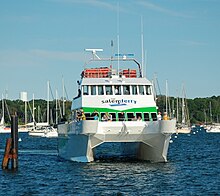
Back قطمران Arabic Катамаран Byelorussian Катамаран Bulgarian Katamaran BS Catamarà Catalan Katamarán Czech Katamaran Danish Katamaran German Katamaran DIQ Καταμαράν Greek


A catamaran (/ˌkætəməˈræn/) (informally, a "cat") is a watercraft with two parallel hulls of equal size. The distance between a catamaran's hulls imparts resistance to rolling and overturning. Catamarans typically have less hull volume, smaller displacement, and shallower draft (draught) than monohulls of comparable length. The two hulls combined also often have a smaller hydrodynamic resistance than comparable monohulls, requiring less propulsive power from either sails or motors. The catamaran's wider stance on the water can reduce both heeling and wave-induced motion, as compared with a monohull, and can give reduced wakes.
Catamarans were invented by the Austronesian peoples, and enabled their expansion to the islands of the Indian and Pacific Oceans.[1]
Catamarans range in size from small sailing or rowing vessels to large naval ships and roll-on/roll-off car ferries. The structure connecting a catamaran's two hulls ranges from a simple frame strung with webbing to support the crew to a bridging superstructure incorporating extensive cabin and/or cargo space.
- ^ Doran, Edwin Jr. (1974). "Outrigger Ages". The Journal of the Polynesian Society. 83 (2): 130–140. Archived from the original on January 18, 2020. Retrieved January 12, 2019.
© MMXXIII Rich X Search. We shall prevail. All rights reserved. Rich X Search